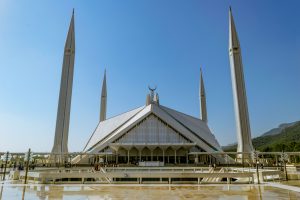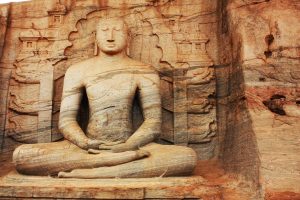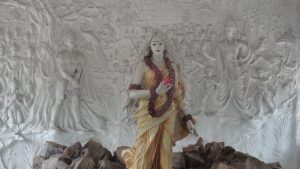74 South Asia: Cultural Geography – Religious Diversity
Islam

Islam is South Asia’s second-largest religion. Muslims make up 97% of Pakistan’s population, 14% of India’s, and 88% of Bangladesh’s, making those three countries, respectively, the second, third, and fourth largest Muslim countries on earth, behind only Indonesia. Despite being a minority religion, there are more Muslims in India than in Egypt and Iran combined, an indicator of India’s enormous population.
Islam arrived in South Asia in the seventh century CE, and over the next few centuries, millions would convert to the faith. Islam got a further boost during the reign of the Moghul Empire, when Islam held imperial status. Muslim communities were established throughout the subcontinent, and were most numerous in the Indus Valley and the Ganges delta. These two areas would become Pakistan (and eventually Bangladesh) after the partition of British India in 1947.
Shortly after partition, about seven million Hindus and Sikhs fled their ancestral homelands for the newly established state of India, and about the same number of Muslims fled India for Pakistan. This mass migration led to countless acts of violence, and up to a million people were killed in skirmishes and riots.
Of course, millions of Muslims remained in India. Many outside observers predicted an endless cycle of violence in India between Hindus and Muslims, but that has not generally been the case. Muslims have held important positions in India’s government and military, and play a prominent role in its economy. It’s quite common for Muslims and Hindus to socialize with one another, particularly in India’s educated middle and upper classes.
Unfortunately, there have been outbreaks of religious violence. In 1992, Hindu nationalists stormed the Babri Mosque in northern India, which was believed to have been built upon the ruins of a Hindu temple. The mosque was destroyed, setting off sectarian riots throughout the county that killed more than 2,000 people. Over the last few years, the relationship between India’s Hindu and Muslim populations has darkened considerably. In 2014, the Bharatiya Janata Party (BJP), a Hindu nationalist party, was elected to lead India’s government. The BJP sees Hinduism as fundamental to Indian identity – a concept known as “Hindutva.” Although party leaders have called for tolerance, many BJP members have been highly antagonistic toward religious minorities, particularly Muslims. Some of the BJP’s more extreme members have even called for the eradication of Islam in India, and dozens have been killed in anti-Muslim riots in recent years.
The origins and traits of Islam are discussed in Chapter 13.
Buddhism

Buddhism originated in India, but only a tiny fraction of the country’s population practices the religion today. Buddhism is similarly rare in Pakistan and Bangladesh, while Buddhists make up 9% of the population of Nepal.
Buddhism is the leading faith, and the official state religion, in both Sri Lanka and Bhutan. 70% of Sri Lankans practice Buddhism, including the vast majority of the country’s leading ethnic group, the Sinhalese. Buddhism was introduced to the island in the third century BCE, making it one of the oldest Buddhist countries on earth. 75% of Bhutan’s population practices Buddhism, which diffused into the country from neighboring Tibet in the 7th century CE. Bhutan is globally famous for its Buddhist temples, convents, and monasteries.
Christianity

Photo by Roehan Rengadurai on Flickr.
Christianity is India’s third-largest religion, accounting for just over 2% of the country’s population, a relatively small share. But, as is the case with Islam, India’s huge population makes it one of the largest Christian countries in the world – there are more Christians in India than in Spain. India also has one of the oldest Christian communities in the world. According to tradition, the religion was introduced to India in the first century CE by St. Thomas the Apostle, and historical evidence verifies that Christianity has been practiced in southern India for at least fourteen centuries. India’s largest Christian population is in the southern state of Kerala. There are also a significant number of Christians in India’s far northeast, and Christian communities in most major cities. The religion was given a boost in the last two centuries by British colonization, and as a result of the efforts of European and American missionaries. Christianity diffused from India to Sri Lanka, where it accounts for about 7% of the population. There are also small Christian communities in Pakistan and Nepal.
The origins and traits of Christianity also are discussed in Chapter 13.
Sikhism

Photo by Riccardo Maria Mantero on Flickr.
Sikhs account for 2% of India’s population. Sikhism originated in Punjab (see Chapter 66), a region in India’s northwest, in the fifteenth century CE. It is rooted in both Muslim and Hindu traditions. Like Islam, Sikhism is monotheistic, and it features some of the standards and practices found in the Quran. Like Hindus, Sikhs believe in reincarnation, and Sikh meditation practices mirror those found in Hinduism. But Sikhism is more than a simple blend of Muslim and Hindu traits – the religion has developed its own unique beliefs and practices over the last six centuries.
As the British were colonizing South Asia, one of their greatest obstacles was Punjab’s Sikh Empire. After two Anglo-Sikh Wars in the 1840s, the Sikhs were defeated and their territory was added to British India. The Sikhs would subsequently become an integral part of the British Empire. The made up a large share of Britain’s colonial army in India, and served in the British military throughout the world. During World Wars I and II, Sikh regiments were some of the most highly-decorated combat units in the British military. Sikhs continue this role in independent India, accounting for a disproportionately large share of India’s military and police officers.
Despite their integral role in India’s security forces, a militant Sikh separatist movement arose in Punjab in the 1970s. In 1984, Indian Prime Minister Indira Gandhi ordered the military to storm numerous Sikh temples in Punjab, and to arrest militants who had taken refuge there. A number of militants were killed in the process, as were many innocent Sikh civilians. In retaliation, Indira Gandhi was assassinated by two of her Sikh body guards. This touched off anti-Sikh rioting throughout India, resulting in the deaths of thousands of people.
Hinduism

Photo by Rahul Mishra on Unsplash.
Although Hindu communities can be found throughout the world, notably in Britain, Malaysia, Canada, and the United States, the vast majority live in South Asia, where Hinduism is the leading religion. Hindus account for 80% of the population in both India and Nepal, and are a significant minority in Sri Lanka (18%) and Bhutan (22%). Small Hindu communities can also be found in Pakistan and Bangladesh.
The origins of Hinduism date back 4,000 years, and are found in holy texts called Vedas, a collection of priestly chants. Over the years, other sacred texts were added to the Hindu tradition, mostly during the second century BCE through the fourth century CE. Hinduism is a polytheistic religion, meaning that it features multiple gods. Three of the most prominent are Brahma, the god of creation, Vishnu, the god of preservation, and Shiva, the god of destruction. But there are many more gods, from dozens to millions, depending on which Hindu tradition one follows. Many Hindus also believe that the gods are a manifestation a single ultimate divinity, meaning that Hinduism can also be considered monotheistic.
Hinduism is a tremendously diverse, individualized, and fluid religion, and varies greatly from region to region, from village to village, and from person to person. The term “Hinduism” itself did not emerge until the 1800s. It was coined by British religious scholars to describe the wide range of belief systems indigenous to India. Because of its diversity, any brief summary of Hindu theology is difficult, if not impossible. Still, most Hindu belief systems tend to have a few things in common. They encourage people to recognize the moral consequences of their actions (karma), to fulfill their duty to society (dharma), and to liberate themselves from selfish thoughts and actions. Another key concept of Hinduism is reincarnation, a cycle in which one is born and reborn into various states determined by their karma.
Hinduism also features the caste system – the division of society into four groups based on occupation and social standing. The brahmins (priests) are the most socially prominent caste, followed by kshatriyas (warriors and rulers), vaishyas (landowners, merchants, and artisans), and sudras (laborers). Within each of these four castes are hundreds of subcastes that more specifically determine one’s occupation. One occupies the caste they are born into, and Hindus are expected to marry only within their caste. Another group, the dalits, are outcasts who occupy the lowest status in society, and who have no caste status.
The modern, urban economy has undermined some of the occupational associations of the caste system, and it is no longer entirely determinant of one’s wealth or status. Some brahmins are poor and marginalized, and some dalits have risen to great economic and social prominence. The caste system has no legal status in India. In fact, it is illegal to discriminate against someone based on caste.
That said, the caste system still plays a tremendous role in Indian society. A person’s daily life – where they live, who their friends are, what they do for a living, and who they marry – is still deeply influenced by caste. In modern India, only a small fraction of Hindu marriages cross caste lines. The upper castes are still wealthier on average, and dalits are still far more likely to live in poverty.
Jainism

Photo by Shravan Suthar on Unsplash.
Jainism represents only 0.4% of the population of India, but even that small percentage comprises over four million people. The Indian government recognizes the Jain faith as one of the country’s official minority religions. Jains are ascetic believers whose principle tenet is to do no harm or injury to any living creature.
Overall, South Asia is a region of great religious diversity.
Did you know?
Cited and additional bibliography:
Khalid, Adnan. Faisal Mosque in Islamabad, Pakistan. Photo, 4 Dec. 2018, https://pixabay.com/photos/mosque-architecture-religion-islam-3850279/.
Mantero, Riccardo Maria. Sikh Prayer. Photo, 15 Aug. 2016. Flickr, https://www.flickr.com/photos/ljsilver71/30887403283/. Attribution-NonCommercial-NoDerivs 2.0 Generic (CC BY-NC-ND 2.0).
Rengadurai, Roehan. Manapad. Photo, 4 Oct. 2014. Flickr, https://www.flickr.com/photos/iamroehan/15717990640/. Attribution-NonCommercial-NoDerivs 2.0 Generic (CC BY-NC-ND 2.0).

